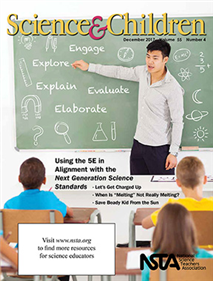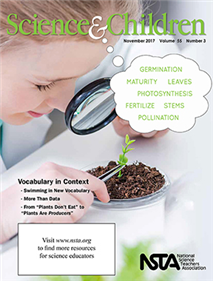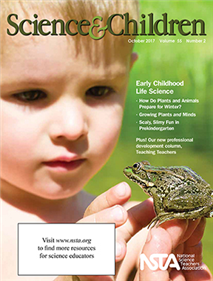All NGSS resources
Journal Article
Methods and Strategies: What’s the Story?
This column provides ideas and techniques to enhance your science teaching. This month’s issue discusses using the 5E learning cycle to create coherent storylines....
Blog Post
A Learning Trajectory for Sensemaking in Science
The Next Generation Science Standards (NGSS) offer teachers the opportunity to consider teaching science in a new way. We help students engage with, wonder about, and make sense of natural phenomena, which closely resembles how scientists perceive th...
By Cindy Workosky
NSTA Press Book
Harnessing Solar Energy, Grade 4: STEM Road Map for Elementary School
What if you could challenge your fourth graders to use solar energy to provide the world with clean water? With this volume in the STEM Road Map Curriculum Series, you can! Harnessing Solar Energy outlines a journey that will steer your students...
NSTA Press Book
Construction Materials, Grade 11: STEM Road Map for High School
What if you could challenge your 11th graders to gain an understanding of the feats of engineering required to build high-rise buildings—and maybe even improve them? With this volume in the STEM Road Map Curriculum Series, you can!...
Journal Article
Methods and Strategies: Time to Change
This column provides ideas and techniques to enhance your science teaching. This month’s issue discusses embedding literacy into the 5E while addressing the principles of the Next Generation Science Standards....
Blog Post
The Engineering Design Process: A Middle School Approach
To support the Next Generation Science Standards (NGSS) Middle School Engineering Design, we have three goals for our students: to define problems accurately, design the best solution using a rigorous process, and evaluate and improve their designs b...
By Cindy Workosky
NSTA Press Book
Toward High School Biology: Understanding Growth in Living Things, Teacher Edition
Would you like to challenge your middle school students to explain a range of phenomena—from how nylon thread can form from two clear, colorless liquids to how a snake that eats only eggs can make body structures such as skin and scales that don’...
By AAAS/Project 2061
NSTA Press Book
Toward High School Biology: Understanding Growth in Living Things, Student Edition
Through 19 carefully sequenced lessons and activities, this unit gets middle schoolers ready for next-level learning. Students explore what happens at the molecular level so they can understand how living things grow and repair their body structures....
By AAAS/Project 2061
Journal Article
Editor's Note: Revisiting the Framework: A Clear Pathway
Science and Children’s editor shares thoughts regarding the current issue....
Blog Post
Seeking a New Way to Assess Science at All Levels
The word assessment can prompt feelings of dread, mistrust, or outright hate in many teachers. That’s distressing, as quality instruction includes quality assessment. Unfortunately, we have allowed assessment to become the “tail that wags the dog...
By Cindy Workosky
Blog Post
Kentucky’s Systems Approach to Assessing Three-Dimensional Standards
One thing is clear about our multi-dimensional standards: They require a complex and thoughtful approach to assessment. No single, conventional, summative test can be expected to provide reliable data sufficient enough to satisfy the demands of all p...
By Cindy Workosky
Blog Post
Gravitational Interactions and 3-D Learning in Middle School
I recently embarked on a journey with K–8 teachers in Vermont to learn how to be intentional about planning for three-dimensional (3-D) learning in the classroom....
By Cindy Workosky
Blog Post
It is truly an exciting time in science education. Science educators across the country are adapting to a new vision of how students learn science guided by the Framework for K–12 Science Education (Framework). As a result, science instruction is c...
By Cindy Workosky





